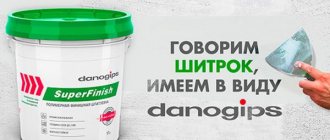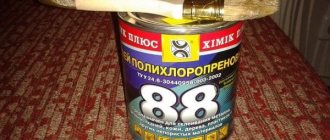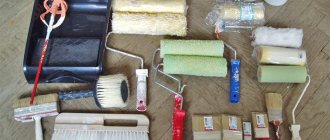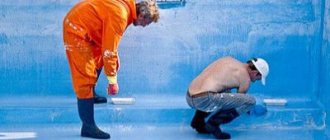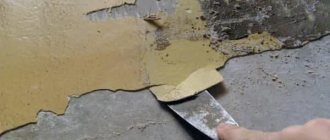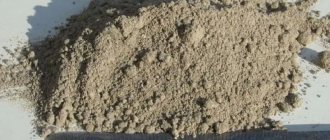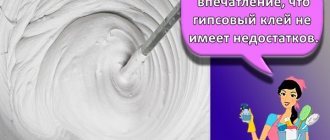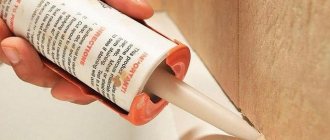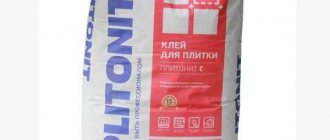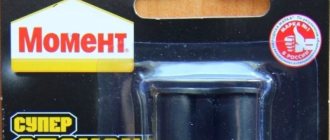SHITROK (Danogypsum) Ready-made putty SuperFinish (28 kg) (17 l) - 1130 rub.\bucket.
Shitrok putty ready-made Superfinish is used in finishing work for finishing application up to 2 mm thick before subsequent gluing of surfaces with wallpaper or paints.
Advantages of Sheetrock Superfinish putty:
- Does not require mixing and is immediately ready for application.
- Excellent elasticity.
- Ideal for finishing coat.
- Easy and high-quality processing of corners.
- The versatility of the selected bases: suitable for both concrete and thin plasterboard sheets, easily sealing the joints between them.
- High quality composition.
- Frost resistance – can withstand up to ten freezing cycles. Defrosting should be done at room temperature, without additional heating.
- Crack resistance.
- Light sanding.
The range of modern finishing materials for plaster and putty allows you to make walls perfectly even and smooth. Among the materials for final finishing, most practitioners especially highlight the finishing putty Sheetrock, or in the original version Sheetrock. Almost everyone who is capable of performing top-class finishing for painting is aware of its existence and capabilities. Shitrok is not cheap, so the finishing mass is used only as the last layer. You can buy several types of SuperFinish produced by Knauf Bauprodukte or APJC, produced at factories of Russian and Greek subsidiaries of the American United States Gypsum.
From Sheetrock to Danogips
The Danogips brand belongs to the Danogips company. In Germany, everyone knows this brand of construction and finishing products, but on the domestic market this name is a new product. The manufacturer produces dry and ready-made mixtures, primers, and gypsum boards. The quality of the goods is very good, and the prices are quite economical.
Ready-made Sheetrock putties also belong to the Danogips brand; they have gone through a design change with updated packaging. In the CIS countries, up to 1/3 of the entire market of ready-made wall putties is occupied by Shitrok. Now on sale there is a line of three products bearing the name of the umbrella brand Danogips, but retaining the composition and properties of Sheetrock.
Sheetrock putty - manufacturers
United States Gypsum Company (USG), headquartered in Chicago (USA), is a major global manufacturer of finishing building materials, whose annual turnover has now reached 3.2 billion USD.
The company arose about a hundred years ago as a result of the merger of several companies working with gypsum. The popularity of its products is evidenced by the fact that a sheet of drywall in the USA is called Sheetrock, and putty is also called Sheetrock. USG today produces and supplies putty for:
- suspended systems for ceilings;
- acoustic ceiling panels;
- plasterboard sheets;
- GKL seams and other necessary products.
The company's production facilities are located literally in all parts of the world, five of them are in Europe, and operate in a continuous cycle. The company recently acquired, along with the trademark rights, a well-known production of suspended ceilings in Germany and became known as USG / DONN.
Features of the material
Putties are suitable for all occasions, therefore they are considered universal. Their main purpose is to level walls made of concrete, plasterboard, brick before finishing, painting, or wallpapering. The description of the material states that it has high ductility. Indeed, the polymer finishing putty Shitrok has a number of advantageous features. They are due to their unique composition, which includes:
- finely ground limestone;
- fine fraction dolomite;
- ethylene-vinyl or acetate-vinyl copolymer;
- pyrophyllite and attapulgite.
The last mentioned materials give a dry sliding effect. This makes it easy to putty the walls on a dry surface. Of course, the composition also contains other components - substances that prevent the mixture from separating, preservatives, thickeners, stabilizers. Also, a special cellulose microfiber is used to add airiness to the mass. Due to its presence, the product becomes like whipped cream. The same component ensures high strength of the layer after puttying. Polyhydric alcohol is added to the composition, which prevents fungus and mold from multiplying.
The features of the material are:
- attaches well to the wall;
- does not fall off the spatula;
- perfectly smooth after drying;
- beautiful white or cream color;
- the mass dries quickly;
- The material is moisture resistant, but quite breathable.
In addition to puttying plasterboard or other surfaces, the material is also suitable for other purposes. Shitrok is suitable for removing cracks and defects on walls made of concrete, brick, and plaster. You can use putty to seal any seam between sheets of drywall on walls, ceilings and partitions, and apply connecting tape on top. Using Shitrok, corners are processed and metal surfaces are finished. With Shitrok you can create a beautiful decorative surface with a certain relief.
Priming as the basis for all work related to putty
The key condition for a puttied surface is that it must be smooth, even and not crumble. If you apply ordinary gypsum-based putty over the previous dry layer, then instead of adhesion, the past layer will absorb liquid from the second or any other future layer. In this case, the quality of the surface will noticeably decrease. Subsequently, this wall or ceiling will inevitably begin to peel off and crumble.
Due to this, during work, before each new layer, the second and each subsequent one, the puttied surface must be primed:
- Between the loose lower layers of plaster and before the putties that follow them, a primer mixture is applied, which has the ability to penetrate deeply into the thickness of the applied materials. In this way, adhesion is ensured in the middle of the 2 layers. The primer will not allow the putty to “slide” and crumble in the future. Moreover, primers with a special quality of good penetration retain loose previous layers of plaster.
- It is better to apply an acrylic-based primer to a layer of putty that moderately absorbs moisture. In case of its absence, a good penetration primer is suitable.
- For moisture-resistant putties, it is better to use primers that are compatible with them. To find out what specific materials will be suitable, you need to look at the jar in which the construction material was purchased. The putty container will indicate on what basis it is made.
- In most cases, you need to prime it twice to create good adhesion.
Material characteristics
The technical characteristics of the material allow it to maintain leadership in the market of similar products. Here are its main parameters:
- drying time - 3–5 hours;
- methods of working with mass - manual, mechanized;
- temperature of application of the material - from +13 degrees;
- density - 1.65 kg/l;
- packaging volume - sold in buckets of 3.5–17 liters.
The high density of the product can be intimidating, because the more dense it is, the more difficult it is to grind the material. But this does not apply to the Shitrock brand. Sanding the dried putty mass is very simple; a mesh with a grain size of 180 units is used for this purpose.
Consumption rates for ready-made putties
Ready-made putty material is a mixture that is a thick consistency, ready for putty. It is usually used to level ceilings against smooth walls or restore carpentry. It is sold in plastic buckets. Such mixtures are an order of magnitude better in quality than dry ones, since they contain substances that give the putty special properties (increasing adhesion, reducing cracking). Although such mixtures are much more expensive, their price is justified by their quality.
Today, the Shitrok mixture is in particular demand. Experts like it for its cost-effectiveness. Its costs with a thickness of 1 mm will be equal to 0.5 kg/m2. Craftsmen appreciate its ease of use, quick drying, and the absence of asbestos and drying cracks.
In addition to this mixture, today Knauf, Pufas and Ceresit are readily used when carrying out repair work. Their consumption can range from 1.5 to 1.7 kg/m2. The consumption of Vetonit putty with a layer thickness of 1 mm is 1.2 kg/m2.
How many bricks are in a pallet: calculations
How many tons of crushed stone are there in a cube?
Table of consumption rates for some types of putties
| Type of putty | Consumption per 1 m2 |
| Facade putty | 1.18-1.6 kg |
| Vetonit | 1.18 kg |
| Oil-adhesive | 3 kg |
| Adhesive | 0.47 kg |
| Plaster | 0.85 kg |
| Finish | 0.44 kg |
| Shitrock | 1 kg |
When preparing for finishing work, remember that their quality depends on the correct choice of material, including putty. When choosing it, consider the quality and nature of the surface. Know that at different stages of work you need different amounts of mixture. If the wall is flat, then the starting putty will need about 1 kg/m2 with a thickness of 1 mm, and the finishing putty 0.5 kg/m2 with a thickness of 0.5 mm. As the layer increases, the consumption will also increase. One layer of putty is rarely needed. The second layer will be thinner. Do not forget that ready-made mixtures are of higher quality and more economical. Remember that you need to add a little extra to the calculated volume of the mixture, because a minimal amount will remain on the spatula and bucket.
We recommend reading
Cement consumption per 1 cubic meter of concrete
Consumption of water-based paint per 1m2
How many bricks are in one cube (1m3): calculations
Advantages and disadvantages
What is better, Shitrok putty or other mixtures? This product has a huge number of advantages that distinguish it from its analogues:
- There is no need to mix the product; it is sold in finished form. After opening, you can immediately start working, which will save time and effort.
- The material is universal, it is suitable for leveling walls and finishing. You won't have to buy another finishing product.
- The product has a unique texture. The oiliness, smoothness, and plasticity of the putty allows it to adhere perfectly to the spatula and the wall. This makes the job much easier for a beginner. Ease of use is due to the ease of rubbing and puttying the layer.
- The fairly low consumption per 1 m2 of putty makes it attractive for those who value calculation and are trying to save money without sacrificing quality. The savings are also due to the thin layer thickness; there is no need for a thick coating.
- The material is sold in containers of different sizes; you can choose the one you need for each individual case.
- After drying, the surface will be very beautiful, smooth, pleasant to the touch, and primer can be easily applied to it. The material does not shrink; the manufacturer guarantees a minimum of 5 years without even small cracks.
- Shitrok will completely replace the primer. To do this, you just need to dilute it with water to a liquid consistency, then use it as a standard primer. Shitrok is also compatible with any brands of other construction and finishing materials.
- The shelf life of the package after opening is several months. If you close the lid tightly and place the material away from heat sources, storage for a year is allowed. By the way, it can be frozen; for further use, you need to defrost it at room temperature.
Shitrock doesn't have many downsides. After application to the wall, the shade of the material becomes not white, but light beige. This may negatively affect the color of the walls, which are planned to be painted white. Also, the disadvantages include the need for thorough preparation of the surface - it must be cleaned, degreased, and leveled in the presence of rough irregularities and defects. If this is not done, the adhesion of Sheetrock to the base will decrease.
Checking the quality of work
The quality of each applied layer must be checked during the work process. If you try to pick off a small piece of the coating and it peels off, it means that the putty work was carried out poorly and adhesion between the layers was not achieved.
To correct the situation, before applying the next leveling or finishing layer, you need to apply a deep penetration primer.
In addition to priming the surfaces to be puttied using factory-made and home-made mixtures, craftsmen can advise before each new stage of work to wet the surface with water once or twice. Thus, the layering of materials is carried out using the “wet” method of applying putty.
To use this advice and carry out putty work in this way, you need to have extensive professional experience. Beginners in this business who are trying to do finishing work with their own hands should not take on tasks of increased complexity.
Product range
There are three products available in the Ready-Mixed category. Among them, users can find one that is useful in a given situation, depending on the purpose of use.
Danogips SuperFinish
Putty of the Superfinish category is a finishing material for the final finishing of the wall. Super finish is a ready-made polymer mass with high adhesion quality, which is suitable for the following surfaces:
- fiberglass;
- drywall;
- painted walls.
The product is not suitable for sealing large cracks and seams. Superfinish gives a perfectly smooth surface.
Danogips Fill&Finish Light
Fill Light putty is also used as a finishing coat. It is suitable for laminating the base and smoothing out small defects. The composition contains latex, which gives the material special strength, scratch resistance, and moisture resistance.
Danogips ProSpray
Danogypsum Pro spray is a multifunctional (universal) product that is suitable for every surface and any type of finish. They can be used to make decorative surfaces, be used to seal seams and cracks, and level the joints of brickwork.
Composition of Shitrok putty - universal
- Limestone CAS 1317-65-3 or Dolomite CAS 12001-26-2
- Ethylene vinyl acetate polymer CAS 24937-78-8 or vinyl acetate polymer CAS 9003-20-7.
- Attapulgite CAS 12174-11-7.
- May contain talc CAS 14087-90-6 or Pyrophylite CAS 12269-78-2.
Notes:
- Limestone or calcite CaCO3 is a traditional building material. Dolomite CaMg (CO3) 2 - often accompanies limestone in deposits.
- The polymer is a regular PVA (poly vinyl acetate) glue.
- Talc is a mineral, hydrous magnesium silicate. Used in medicine, cosmetics and technology. In everyday life, powder with talc is known.
Pyrophylite is a mineral containing silicon and silica.
Application technique
How to work with the material? There are no particular difficulties or differences from working with other putties. It is only important to prepare the surface for processing, while the humidity in the room should be minimal. To prepare, do the following:
- clean the walls of old coating;
- level differences of more than 2 cm;
- perform priming.
After complete drying, you can start working with Shitrok. Take a little material from the bucket, place it in a convenient container, and place it on the floor or on a stand. Take the putty with a spatula and apply it to the wall in one thin layer. Layer thickness is 1–2 millimeters. After covering the entire wall, you need to take a break for drying - 3-5 hours. Then you can do sanding. The consumption for fiberglass is higher, since 3 layers need to be applied, in other cases 2 layers are enough.
There are some peculiarities in the use of putty in different versions. When finishing seams, work is done as follows:
- take a 12 cm spatula and use it to fill the seams with the prepared mixture;
- Place the tape in the center and press it in;
- remove the mass that has come out at the edges, apply a little of it on top of the tape;
- seal the fastener heads with material (if necessary);
- After 3 hours, apply a second coat and sand as it dries.
When finishing internal corners, putty is applied to 2 sides of the tape with a 12-centimeter spatula. Then the tape is folded in the center, pressed to the corner with a spatula, and the excess mass is removed. After drying, repeat the steps 2 more times. At the end of the work, wipe the surface with a damp sponge.
Material consumption
Before starting work, it is important to use a calculator to calculate the required amount of material. Standard consumption is liter per 1 square meter. More is spent on the joints of plasterboard sheets - 28 kg are spent per 55 m of linear seams, or 0.51 kg/m linear. Texturing consumes 28 kg per 20 square meters. m, or 1.4 kg/sq. m.
Using putty when processing internal and external corners
You know the consumption of “Shitroka” per 1 m2. However, before starting work, you should also learn about corner processing technology. It is necessary to prepare a piece of corner or tape in advance. To achieve an ideal result, you should use professional angles from the same manufacturer.
It is necessary to apply a layer of putty to the surface on both sides of the corner with a narrow spatula. A corner or tape is fixed to the surface. Under the tape, spread the material from the middle to the edges. This way you can stick the tape and remove the excess layer and level the surface. Next you should wait until it dries completely. Then you can apply a layer of tape or corner using a 30 cm spatula. As soon as the layer has dried, you can begin continuous puttying.
Sheetrock, Knauf “Rotband paste” or Vetonit LR - which is better
The materials listed are the most popular among finishers. But there are features that must be taken into account when choosing. Thus, Shitrok creates the smoothest surface even without sanding. After sanding, it must be primed, but without sanding this step can be skipped. Shitrok is ideal for painting, the most durable.
Primer must be applied on top of Vetonit; this material is best suited for subsequent wallpapering. The disadvantage of Vetonit in comparison with Shitrok is less plasticity, but the color is perfectly white. Another disadvantage of Vetonit is the need for dilution, while Shitrok is a ready-made mass.
When comparing Shitrock and “Rotband paste” from Knauf, the following should be noted. There are few differences in the recipe; Knauf also makes high-quality material with small marble particles and a polymer matrix. The surface after finishing coating from Knauf remains perfectly smooth; it does not need to be polished or sanded. Typically, “Rotband paste” is purchased if a thicker layer is planned to seal wall defects. Shitrok involves thin application - up to 2 millimeters. You should select the material based on your needs - then the quality of the work will not cause any complaints.
What is included in the consumption of finishing putty per 1m2?
Rotband plaster instructions for use for beginners
Since finishing putty is a layer that is called a smoothing layer, this type of “smoothing” requires precise calculation, because you are probably preparing the wall for painting, wallpapering or sculpting. The construction crews hired by ordinary people do not offer an accurate calculation of consumables, but a obviously larger quantity of them. This percentage does not always correspond to actual costs, but foreman-schemers, relying on the low cost of a bag of finishing material, often increase its quantity not by a couple of additional units of production, but by dozens.
Of course, you can’t calculate up to a kilogram, but with an error of 10% you can make a pretty decent calculation. The type of putty, naturally, plays a role, but here the curvature of the surface also makes its contribution.
First, read the manufacturer's instructions; you will still be guided by it. For example, the starting material contains gypsum (it seals large cracks and chips well). With smooth walls, about a kilogram of putty is usually used per square meter. If we take into account all the wall defects, as well as a thicker layer of material (10 millimeters), then the consumption can increase to 8 kilograms. And this is only one layer, and if there are 2 of them, then the material consumption increases by 100 percent.
The finishing material manifests itself differently. It is not applied in a thick layer (maximum 1 mm), so the material consumption is reduced by 10 times compared to the starting putty, that is, per square meter you will need no more than a kilogram of the finished mixture, or even less: sometimes you can invest in half a kilo.
primer between coats of shitrok
There is the following situation. The ceiling was lined with sheet metal and poorly painted. The paint has been stripped off. After this, there is a need to trim the sheetrock again with a sheetrock. The old layer is chalking. Dry or wet cleaning doesn't really help. In this case, does it make sense to prime the old layer of Shitrok?
Well, the primer won’t ruin anything, why are you afraid to prime it?
It has. You just need to first try the primer in an inconspicuous place and experiment with its dilution, otherwise it may happen that the putty is washed off during the priming process.
deep penetration - not needed, regular universal acrylic.
july-m wrote: try the primer in an inconspicuous place and experiment with its dilution, otherwise it may happen that the putty is washed off during the priming process.
In my opinion, on a stripped ceiling, no matter where you poke, any place is invisible.
And in order not to spend money on various tests, we can immediately say that water-based primers (others are not used on the ceiling) necessarily dissolve water-soluble putties. even if the top layer of Shitrok dissolves, it doesn’t matter - it will soften and dry out again, only after priming it will become even stronger. So, prime without fear. Thanks to all. I doubted it, because in many places they write that the shitrock does not need to be primed. In my heart I understand that I need to prime, but you never know
Which primer would you choose? There is an opportunity to buy:
- OLIMP deep penetration
- Ceresit CT17
- Knauf Tiefengrund
- Eunice universal
- Eunice deep penetration
And which one would you recommend to use after sanding before painting? Dulux Innetak paint.
july-m wrote: . otherwise it may happen that the putty is washed off during the priming process.
If you use a garden sprayer rather than a roller or brush to apply the primer, then there will be no way for the primer to wash off
PS The main thing is to make sure that the soil does not hang in drops on the ceiling.
ceresite has a yellowish color
because in many places they write that the shitrock does not need to be primed
It is necessary to prime after dusting, i.e. sanded, peeled - before the next layer
baly wrote: ceresite has a yellowish color
won't a thin layer of shirt cover up the yellowness?
Gray wrote: water-based primers (others are not used on the ceiling) - they must dissolve water-soluble putties
In expensive putties like Shitroka, in addition to gypsum, there are also a bunch of polymer additives. They make it resistant to wetting. Compared, for example, with Volma-Finish - earth and sky
